
Big Bend National Park
Having explored the rest of Big Bend area, we allocated a week to Big Bend National Park. It was well worth it. We stayed in two campgrounds, Chisos Basin and, when the temperatures dropped below freezing, breaking records for the Park, we moved to a lower altitude at the Rio Grande Village campground. The Rio Grande River forms the lower boundary of the park for 118 miles separating it from Mexico. The park contains the largest protected area of the Chihuahuan Desert and contains over 1200 species of plants, birds, mammals and reptiles. The Geology of the area is very complex and includes a period when the park was connected to the ocean so many fossils, including dinosaurs, have been found.
Chisos Basin
The drive into Chisos Basin is very dramatic through a pass between the highest peaks which reach almost 8,000 feet above sea level. The campground is located in the basin, completely surrounded by jagged-topped mountains. At the visitor center we inspected a map showing recent bear and mountains lions (none seen during our stay). I attended a geology talk by one of the Park Rangers and learned that the basin was formed, not as a caldera as he first thought, but by sediment being washed down between the mountains and having no place to exit. The sunrise and sunset hours were spectacular with the surrounding cliffs being touched by the light. The Chisos Mountain Range is the only range in the US completely enclosed in a National Park.
Click on any thumbnail below to see larger image gallery.
- Wildlife Warnings
- Campground
- Geology lecture
- Road Runner
- Sunrise over the Chisos
The Window
As the sediment in the basin built up in time, water eventually found the lowest point to exit. This narrow exit where all water exits down a 220 foot cascade to the desert below is known as the ‘Window’. It is also located where the sun sets at some times during the year. We did a short hike to watch the sun set on our first night and the following day I hiked the trail across the basin down to the Window and back. The trail through the desert scenery ended up in a river bed where water gradually appeared and eventually cascaded over the edge.
- Sunset in the Window
- Rock detail
- In front of the Window
- Cascade source
- Agave flower
- Sunrise at the Window
Santa Elena Canyon
The Rio Grande cuts several canyons through the mountains and the Santa Elena Canyon is the most impressive. The cliffs rise to over 1,000 feet on both the US and Mexican sides and the canyon entrance can be seen over 10 miles away. We both took the trail up the side of the canyon which rises steeply in the beginning and then descends again to water level before the canyon sides meet the river and end the trail. Finding the beginning of the trail was a bit tricky as it involves crossing the Terlingua Creek (a tributary of the Rio Grande) and scrambling up the river bank to find the trail. We learned that the lack of any trail signs is because the creek frequently changes its course. Fortunately there were enough hikers around so that word of mouth directions were passed to us on the way up. We were able to help hikers as we came down and back across the creek. The canyon provides an echo chamber at the end of the trail which amused many of the hikers.
- Canyon entrance
- By water
- Cheryl on her way back
- Dewy
- Old equipment at Castalon Visitor Center
- Layers
Balanced Rock
Having seen pictures of Balanced Rock in Big Bend brochures, I wanted to see it for myself and provide my own photographic interpretation. The Ranger at the Chisos Basin Visitor Center had assured me that the unpaved road to the trailhead was of high quality, no special vehicle required. However, the 7 mile journey down the road was a bit nerve-racking, particularly for Cheryl, as the road quality worsened the further we drove. In spite of the noise of rocks hitting the van, the rocking right to left over the huge potholes, I still wasn’t about to give up and we made it to the trailhead and waited for our dust cloud to settle. (I can’t see us on an unpaved road again until Cheryl’s memories have faded over time – and perhaps any repairs paid for). The hike was classified as moderate and indeed it was easy, leading through a valley between high peaks to the final climb up into the pass. The last quarter of a mile proved a lot more difficult, more like rock climbing than hiking, but I finally made it to the top just as the setting sun’s rays were leaving the balanced rock structure. The climb down was just as hazardous (mental note: I need a different way to carry my camera to leave both hands free) but I made it back into the valley with only a shin scrape. The ride back along the road didn’t seem quite as bad but we were both glad to reach the paved road and make it back to the campsite before dark.
Boquillas, Mexico
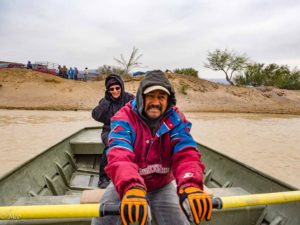 Big Bend National Park contains the only unmanned border crossing from the US to Mexico. It is reached by wading, swimming, or most commonly by hiring a rowboat across the Rio Grande for the princely sum of $5 round trip. The village of Boquillas, Mexico is a mile or two from the other side of the river and can be reached on foot, by burro, or by hiring a pick-up truck and driver. It was a very cold day (record low temperatures) and very windy so we went for the rowboat/pickup option. It was a good choice as we later learned, the burros often decide to go home instead of to the village, stranding their passengers. Our driver (and guide for the visit) Chalo Diaz was very pleasant and spoke English well, answering all our questions about life in Boquillas. The nearest town is 150 miles (the first 50 unpaved) and so they are dependent on a weekly truck delivery for food and supplies.
Big Bend National Park contains the only unmanned border crossing from the US to Mexico. It is reached by wading, swimming, or most commonly by hiring a rowboat across the Rio Grande for the princely sum of $5 round trip. The village of Boquillas, Mexico is a mile or two from the other side of the river and can be reached on foot, by burro, or by hiring a pick-up truck and driver. It was a very cold day (record low temperatures) and very windy so we went for the rowboat/pickup option. It was a good choice as we later learned, the burros often decide to go home instead of to the village, stranding their passengers. Our driver (and guide for the visit) Chalo Diaz was very pleasant and spoke English well, answering all our questions about life in Boquillas. The nearest town is 150 miles (the first 50 unpaved) and so they are dependent on a weekly truck delivery for food and supplies.
Mexican Customs and Immigration consisted of a hand-wave from an official in his trailer and we toured the town with Chalo, visiting his home, meeting his family and seeing the school and a clinic. Chalo was very proud to show us that all the village power was Solar-generated from the small facility at the end of the village. We dined in a local restaurant/bar with Chalo, and walked into some of the cultural buildings on the main street, which was just a dirt road. The town consisted of about 12 business buildings, and had no more than 75 one-room houses. We only saw one fenced-in garden area for fresh vegetables. On our way back, Colin persuaded the rowboat owner to let him row back across the Rio Grande, which proved a bit tricky with strong wind and current, but managed to reach the other bank close to the desired arrival beach. The ‘unmanned’ crossing was a bit of a misnomer as we discovered on re-entry to the US. A Park Ranger supervised us as we stood in front of a camera and spoke to a Customs and Immigration official by phone, who quizzed us about what we were bringing back, while our passports were being scanned.
In the late afternoon, we visited Boquillas Canyon, another steep-walled canyon cut by the Rio Grande through the huge, angular Sierra Del Carmen mountains. A trail from the parking lot leads over a ridge into the canyon which is navigable on foot for about two miles.
- ‘Unmanned’ Port of Entry
- Chalo Diaz, our guide
- RC Church
- Church interior
- Boquillas bar
- View from Boquillas over the river
- No shortage of furry friends
- Colin rowing back to the US
- Boquillas Canyon
- Beaded insects for sale
- Boquillas from the US
Rio Grande Village
We stayed the next two nights in the National Park’s Rio Grande campground. I took an early morning hike on the Nature and Overlook Trails and was happy to discover a pair of Blue Herons occupying a spot under the floating dock structure used for a part of the trail. The early morning view from the top looked back over to Boquillas in one direction and over the campground to the Sierra Del Carmen mountains in the other. There were several ‘unmanned stores’ on the trails in this area (see picture) with trinkets from Boquillas Village for sale. We never did find out how the money and goods were transferred across the border.
- Cottonwoods
- New use for a Floating Dock
- Blue Heron
- Trinkets for Sale
- Sierra Del Carmens
- Boquillas from US
Hot Springs
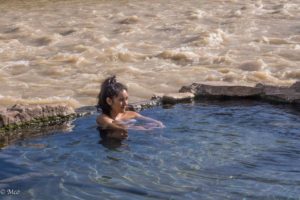 We had heard about the Hot Springs in this area of the park and wanted to take a drive to look, or even to take a dip. However this was vetoed when it became clear that this would involve driving on another unpaved road. So I hiked the alternative 6 mile trail over the ridge and along Hot Springs Canyon rim from the campground to the Hot Springs. The Springs themselves were pretty unusual, showing the contrast between the fast-flowing, muddy Rio Grande and the spring-water pool which sat right next to it. There was only time for a quick foot-dip before returning along the trail, which provided some great views of the river gorge with the Sierra Del Carmen behind.
We had heard about the Hot Springs in this area of the park and wanted to take a drive to look, or even to take a dip. However this was vetoed when it became clear that this would involve driving on another unpaved road. So I hiked the alternative 6 mile trail over the ridge and along Hot Springs Canyon rim from the campground to the Hot Springs. The Springs themselves were pretty unusual, showing the contrast between the fast-flowing, muddy Rio Grande and the spring-water pool which sat right next to it. There was only time for a quick foot-dip before returning along the trail, which provided some great views of the river gorge with the Sierra Del Carmen behind.
Click on map below to see larger version
Big Bend National Park, Texas
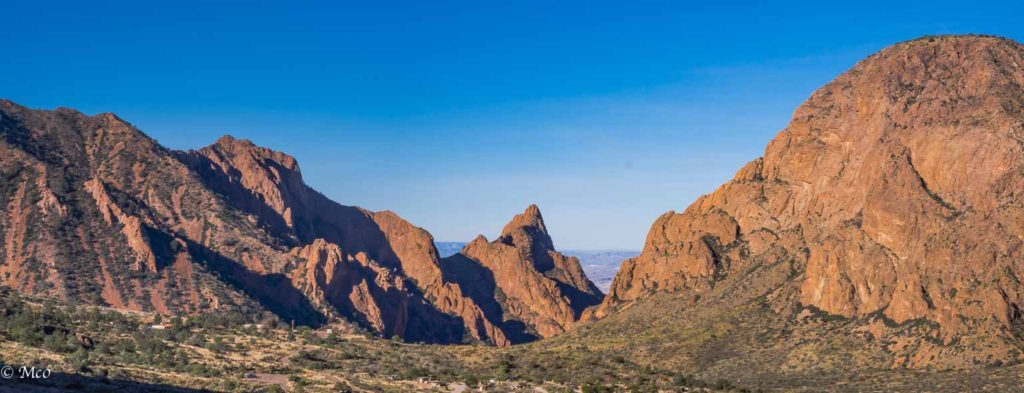
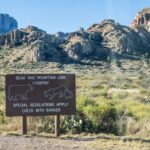
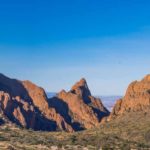
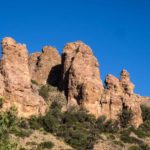
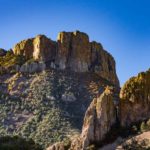
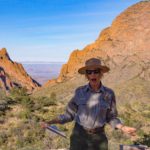
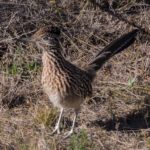
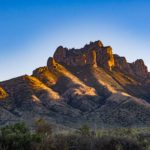
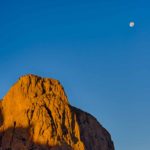
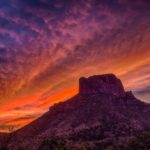
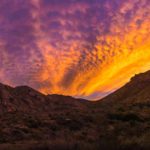
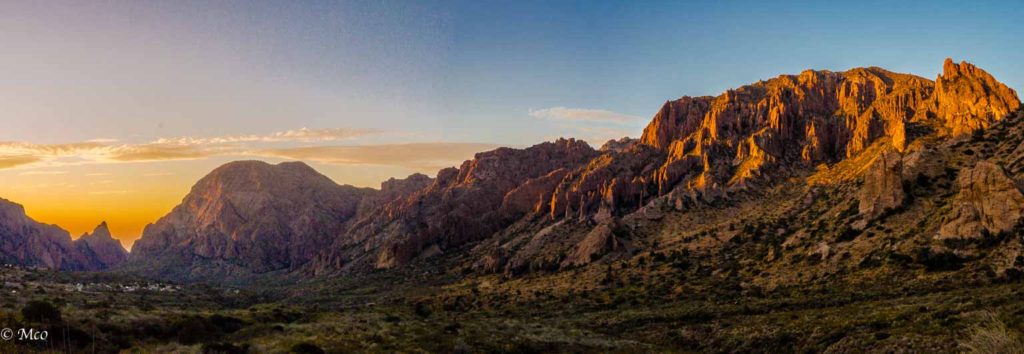
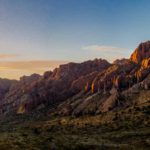
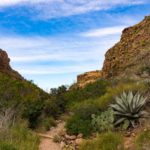
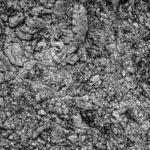
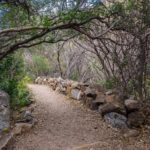
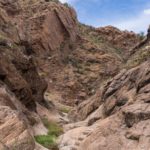
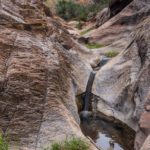
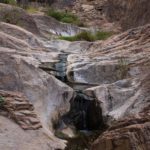
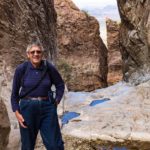
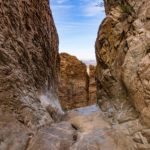
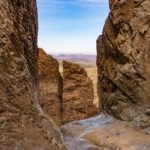
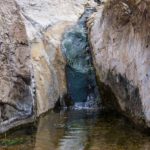
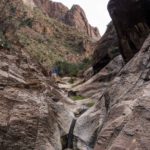
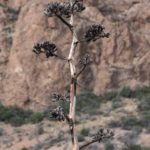
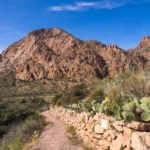
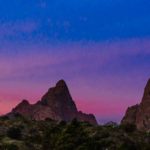
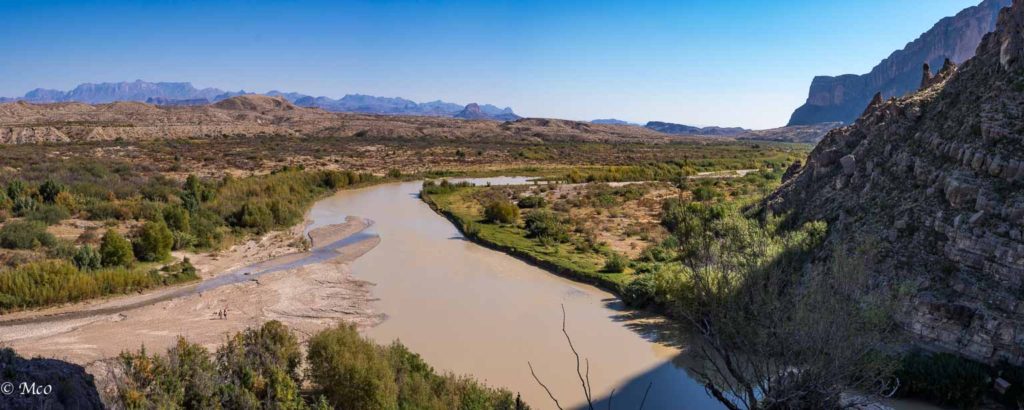
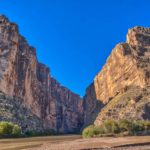
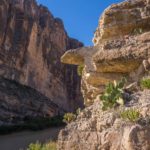
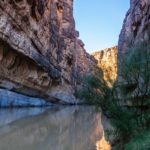
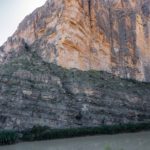
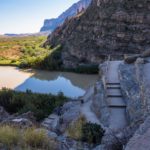
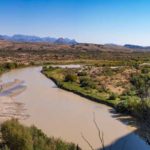
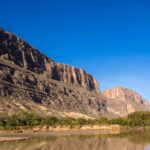
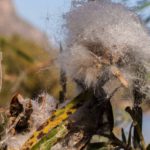
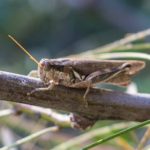
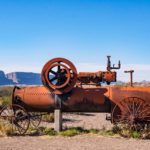
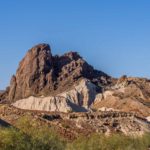
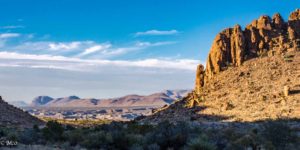
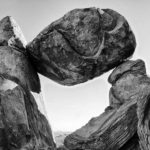
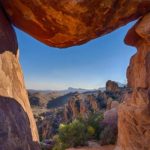
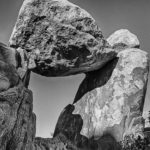
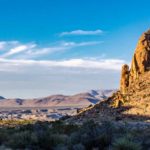
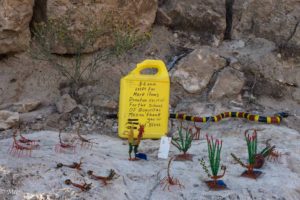
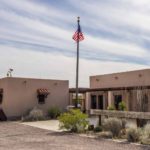
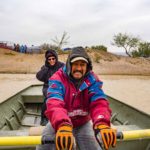
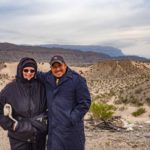
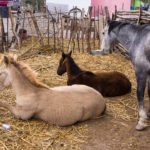
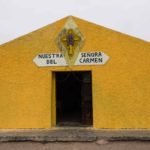
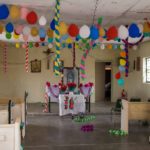
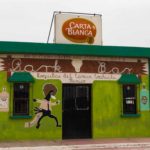
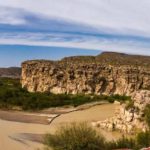
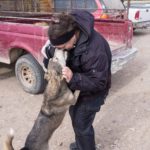
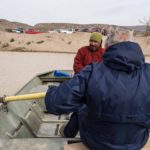
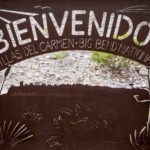
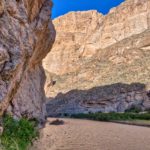
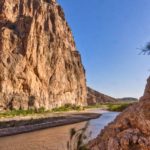
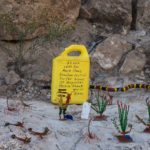
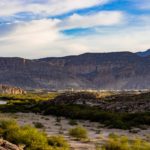
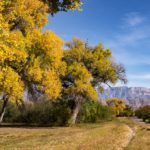
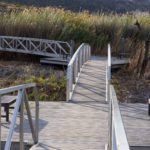

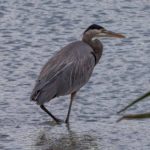
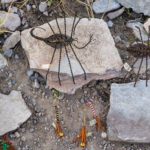
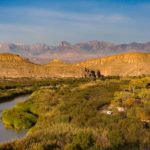
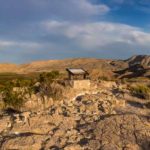
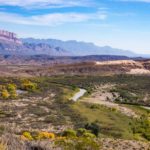
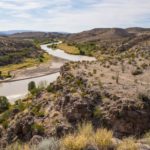
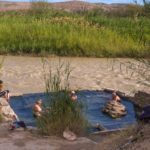
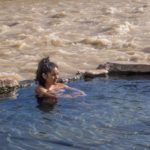
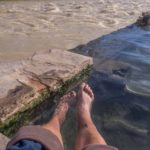
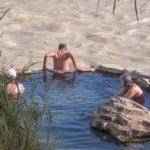
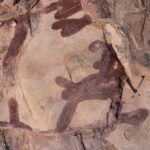
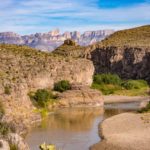
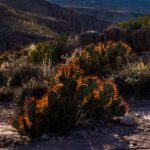
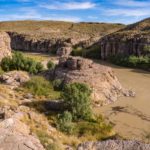
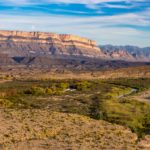
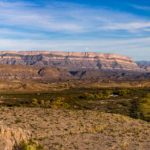
Too much awesomeness to even comment on! The whole area, which I had never heard of before, is just totally spectacular. Hard to pick my favorite shots, but I’ll have to go with the sunrises, Balanced Rock (worth the risk to your lives?), and so many of those beautifully lit canyon photos, plus the springs next to the river, plus…..all of them! I have a big dose of cabin fever, so these blogs helped me pretend I was there. Actually GOING there with you as guides would be even better!
From Cheryl: You are just amazing on how you are the first to always send us feedback, and your lovely compliments. We love that you are with us, so we’ll have to plan a trip together, going with you and Steve, getting music into our travels, getting photo opportunities for you and Colin, all would be better than grand. So happy you enjoyed the area. We hadn’t heard about it either. It was recommended by a fellow traveler.
I love the pics and the stories kept me on the edge of my seat! You two are getting very daring. I’m glad your ride was the only thing that needed repairs. SAFE travels, please. 🙂
From Cheryl: So glad you enjoyed our daring travel story, but all was well in the end. We did it again last night on a rough road and then we both had nightmares about getting stuck in muck and having to call not just a tow truck, but possibly a crane. We’re safe and now repeat the mantra: This is NOT a 4-wheel drive. We only have 30 inches wheel base clearance. Be careful!